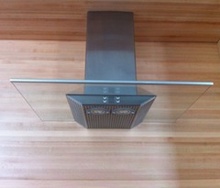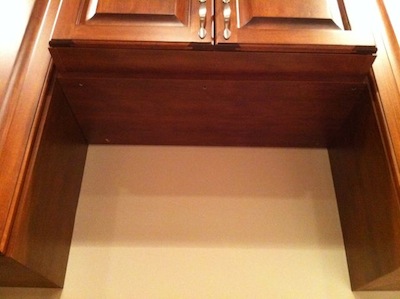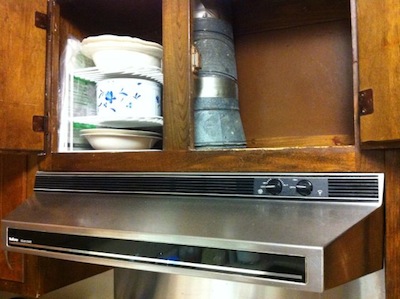Recirculating Range Hoods — As Effective As Recirculating Toilets

You’d never settle for a recirculating toilet, would you? Press the lever and everything in the bowl just swirls around and around. Never leaving, just recirculating. That’s the image Professor John Straube painted for us last week in his talk at the Building Science Experts’ Session. He was discussing range hoods and indoor air quality (IAQ).
Think about it. You’re cooking for the holidays. A pot is sitting on one of the burners with no lid, vapors rising from it into the air. You turn on another burner to sauté some onions and something that spilled onto the burner another time starts burning off, creating a little bit of smoke. You’ve got a turkey going in the oven. The kitchen’s getting a little warm and steamy, so you turn on the range hood.
It’s making noise. You know the air is moving because you feel it hitting your forehead. But is it really helping to clear the air? No! It’s taking air from the kitchen and putting it back into the kitchen. Yeah, it may capture some of the grease and odors in that little metal mesh filter, so that may explain the acne on your forehead.
But it’s not really doing much to help your indoor air quality. To accomplish that, the range hood has to pull in air from the kitchen and send it outside.
Why do you want a range hood that vents air to the outside? Let me count the ways:
- Carbon monoxide – If you have a gas range, especially one with a gas oven, you may be putting elevated levels of carbon monoxide in your air.
- Formaldehyde – one of the things you get from heating oil
- Other toxins – Those bits of grease and food that get burned off create airborne toxins you really don’t want to breathe.
- Moisture – Cooking can put a lot of water vapor into the air.
- Odors
How can you tell if your range hood is vented?

The photo above shows the cabinet niche where a range hood goes. Since this builder also installed ventless gas fireplaces, I imagine that they installed the range hood right in that spot without first cutting a hole for the duct to vent the air to the outside. Sometimes you can tell if your range is vented to the outside by opening the cabinet doors above it. The photo below shows a duct running through that small cabinet.

It’s possible, though, that the range hood is vented straight through the wall to the outside. To tell if that’s the case, go outside and look at the wall to see if there’s a wall cap to allow the vented air to escape. Of course, if the range hood isn’t mounted on an outside wall, it probably wont’ be vented like this. (I say ‘probably’ because there’s a lot of weird stuff out there in existing homes.)
If you can’t find a duct anywhere, and you feel strong air flow from the front of the range hood when you turn it on, it’s probably a recirculating model.
Venting to the outside is just the beginning
Yes, you certainly want a range hood that pulls air in and sends it to the outdoors, but there’s a bit more to it than that. You also want to make sure you’re capturing enough of the air, so you need a hood that actually covers the range. If it doesn’t, you can use the back burners to get better ventilation.
You also want to make sure it’s really moving air. This is one of the requirements in version 3 of the ENERGY STAR new homes program. The HVAC Quality Installation Rater Checklist requires the home energy rater to measure the air flow of the range hood to ensure that it’s pulling at least 100 cubic feet per minute. If you’ve read my article on air flow in bath fans, you know that there can be a lot of problems that reduce air flow.
For an excellent overview of the problems with range hoods, see Carl “The Green Curmudgeon” Seville’s article at Green Building Advisor on the topic from earlier this year: Why Range Hoods Don’t Work.
Allison A. Bailes III, PhD is a speaker, writer, building science consultant, and the founder of Energy Vanguard in Decatur, Georgia. He has a doctorate in physics and is the author of a bestselling book on building science. He also writes the Energy Vanguard Blog. For more updates, you can subscribe to the Energy Vanguard newsletter and follow him on LinkedIn.
Related Articles
Don’t Let the Turkey Get You Down! Carbon Monoxide Alert
Bob Vila and the Vent-Free Gas Fireplace — A Sorry State of Affairs
5 Reasons Bath Fans Have Such Poor Air Flow
Don’t Compromise — Get a Low-Level Carbon Monoxide Monitor
A Day with Professor Straube at the Building Science Experts’ Session
Comments are closed.
This Post Has 16 Comments
Comments are closed.

Man! I see these “things
Man! I see these “things” in Germany all the time. It makes absolutely no sense! It’s almost as bad as ventilatin without make-up air. Love the toilet analogy.
S Waldron, I agree that ICC
S Waldron, I agree that ICC needs to address this by removing the exception to the requirement that “Range hoods shall discharge to the outdoors…” -M1503.1 IRC2006.
Manufacturers also need to make range hoods quieter like they’ve done with the newer bath fans. They’re getting better, but many hoods are not used because you can’t hear yourself think over their motor and fan.
My home has a second cook surface on the island with a downdraft vent. These are almost as bad as recirculating fans because all the hot air, steam, and contaminants rises away from the low-positioned vent inlet.
While I’d agree that using a
While I’d agree that using a recirculating range hood as a standalone kitchen ventilation strategy is useless, using one of these WITH an HRV exhaust intake in the kitchen is the most effective & energy efficient way to ventilate a kitchen. When you see the Germans using ductless range hoods, I bet in most cases they’re following this strategy. The charcoal filter retains some of the grease & particulate matter, while the HRV intake handles the smoke, & cooking gases.
NOTE, if you have a gas range, a direct exhaust range is mandatory to exhaust combustion gases.
Until its code, builders wont
Until its code, builders wont ever do it on tract homes.
100 CFM is never enough
100 CFM is never enough unless you only boil eggs in a small pot next to the wall. Typical kitchen exhaust are pulling from a wide area leaving low velocities at the range hood that spill most of the visible steam from a pot on the outside burner if the flow is around 250 CFM. At 100 CFM you’ll get less than half going out the kitchen exhaust.
I suggest surounding the stove on 3 sides with stainless steel, right down to the counter top. This keeps the velocity at the range top high enough to catch most of the steam and such. Also eliminates splatters on the counter.
I have a Stainless surround on on side and with the burners against the wall and close to 300 CFM, I catch most of the steam. Not all. Pity the 100 CFM fan, open on all sides which won’t do much more than the blow in your face models.
@Thomas, I agree with you re:
@Thomas, I agree with you re: downdraft exhausts. At best, they require a lot more energy to do the same job.
Regarding building codes, according the Section M1503.1, recirculating hoods are only acceptable IF ventilation is provided by other means (as defined in Section 1507.3)
At some point this all
At some point this all becomes ridiculous. Typical young professional family spends an hour in the kitchen each night 10-20 minutes of which cooking.
Typical young professional spends 30-60 minutes in the car commuting and breathing in a much heavier dose of chemicals and particulate matter coming off of the entirely plastic interior of the car as well as the road pollution. Answer stop eating and stop driving.
Allison, what is your take,
Allison, what is your take, (or Straube’s take) on what Stuart Fix suggested above? This is what I most commonly see on Passive House projects. I’ve yet to hear from any homeowners (albeit there are few) that the set up is problematic.
Sorry, this article is low on
Sorry, this article is low on the knowledge scale. We’ve lived in 6 different countries and, outside of the USA, we’ve almost always had ductless fans. Think Germany, Italy and Switzerland, all countries we’ve lived in and had ductless fans. And, all countries with more of a cooking tradition than the US and produce far higher end cooking appliances.
In the USA, our home has an outside vented 1,200 cfm attic mounted Fan Tech, drawing from a 42″ stainless hood, thru both a wire mesh filter and a Swiss tight mesh replaceable fabric filter. A 36″ muffler completes the install.
It works well but no better than the ductless fan in our Swiss home, which is quieter, better looking, easier to install and cheaper.
Ray: Sorry
Ray: Sorry, your comment is high on the assumption scale. The range hood is part of the ventilation system, and yes, it’s certainly possible to have a kitchen with a recirculating range hood that works well in the overall ventilation system. If you have a gas range or oven, though, they’re a big NO-NO. If you don’t have some source of pulling air out of the kitchen, they’re not adequate.
In Europe, from what I understand, they’re integrated into the whole-house ventilation system. When you see recirculating range hoods in the US, they’re typically not integrated.
@Ray, aside from the CO issue
@Ray, aside from the CO issue that Allison mentioned, just how does a recirculating fan get rid of moisture?
all toilets are recirc
all toilets are recirc toilets.
So does this mean that, if
So does this mean that, if your living situation is such that there is no possible way to vent to the outside, there’s no point in getting a range hood? Please help, I’m struggling with this…Thanks, Diana.
PS – I have an electric range.
@Diana, a recirculating hood
@Diana, a recirculating hood is certainly better than none. It will filter contaminants, but not moisture. As long as your home isn’t super tight, that shouldn’t be an issue in the winter, but it will add to your latent (humidity) loads in the summer. Whether or not your AC can handle this is another matter.
You can get better results
You can get better results with a recirculating model if you use a carbon filter, which is often an option. Check the website of the manufacturer and see if they sell a carbon filter in the parts section for your model hood. Otherwise, you need to vent outside or open all the windows!
Alternative solution: The Raw Food Diet.
You did a great job of
You did a great job of explaining the difference between vented and ventless range hoods. What would you suggest for someone who cannot install ductwork?